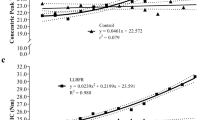Abstract
Purpose
Unaccustomed exercise can result in delayed onset muscle soreness (DOMS), particularly as a result of the eccentric phase of the muscle contraction. Resistance training combined with venous blood flow restriction (vBFR) may attenuate DOMS, but the available information in this regard is conflicting. Therefore, the purpose of this study was to examine the effects of low-load eccentric vBFR (Ecc-vBFR) and concentric vBFR (Con-vBFR) resistance training on indices of DOMS.
Methods
Twenty-five previously untrained women completed seven days of either Ecc-vBFR (n = 12) or Con-vBFR (n = 13) forearm flexion resistance training at a velocity of 120° s−1 on an isokinetic dynamometer. The Ecc-vBFR group used a training load that corresponded to 30% of eccentric peak torque and the Con-vBFR group used a training load that corresponded to 30% of concentric peak torque.
Results
There were no differences between Ecc-vBFR and Con-vBFR at any of the seven training sessions on any of the indices of DOMS. There were no decreases in the maximal voluntary isometric contraction torque which increased at days 6 and 7. Similarly, there were no changes in perceived muscle soreness, pain pressure threshold, elbow joint angle, or edema (as assessed by echo intensity via ultrasound) across the seven training sessions.
Conclusions
The Ecc-vBFR and Con-vBFR low-load training protocols were not associated with DOMS and there were no differences between protocols when performed using the same relative training intensity. These findings suggested that both unaccustomed eccentric and concentric low-load training did not result in DOMS when combined with vBFR.





Similar content being viewed by others
Abbreviations
- Ecc-vBFR:
-
Eccentric venous blood flow restriction
- Con-vBFR:
-
Concentric venous blood flow restriction
- vBFR:
-
Venous blood flow restriction
- DOMS:
-
Delayed onset muscle soreness
- MVIC:
-
Maximal voluntary isometric contraction
- PPT:
-
Pain pressure threshold
- 1RM:
-
One repetition maximum
- MD:
-
Minimal difference
- SEM:
-
Standard error of measurement
- ICC:
-
Intraclass correlation coefficient
References
Abe T, Kearns CF, Sato Y (2006) Muscle size and strength are increased following walk training with restricted venous blood flow from the leg muscle, Kaatsu-walk training. J Appl Physiol 100(5):1460–1466
Andersen H, Arendt-Nielsen L, Danneskiold-Samsoe B, Graven-Nielsen T (2006) Pressure pain sensitivity and hardness along human normal and sensitized muscle. Somatosens Mot Res 23(3–4):97–109
Barbalho M, Rocha AC, Seus TL, Raiol R, Del Vecchio FB, Coswig VS (2019) Addition of blood flow restriction to passive mobilization reduces the rate of muscle wasting in elderly patients in the intensive care unit: a within-patient randomized trial. Clin Rehabil 33(2):233–240
Buckner SL, Dankel SJ, Mattocks KT, Jessee MB, Mouser JG, Counts BR, Laurentino GC, Loenneke JP (2017) Differentiating swelling and hypertrophy through indirect assessment of muscle damage in untrained men following repeated bouts of resistance exercise. Eur J Appl Physiol 117(1):213–224
Clarkson PM, Hubal MJ (2002) Exercise-induced muscle damage in humans. Am J Phys Med Rehabil 81(11 Suppl):S52–69
Counts BR, Dankel SJ, Barnett BE, Kim D, Mouser JG, Allen KM, Thiebaud RS, Abe T, Bemben MG, Loenneke JP (2016) Influence of relative blood flow restriction pressure on muscle activation and muscle adaptation. Muscle Nerve 53(3):438–445
Crameri RM, Langberg H, Magnusson P, Jensen CH, Schrøder HD, Olesen JL, Suetta C, Teisner B, Kjaer M (2004) Changes in satellite cells in human skeletal muscle after a single bout of high intensity exercise. J Physiol 558(Pt 1):333–340
Curty VM, Melo AB, Caldas LC, Guimaraes-Ferreira L, de Sousa NF, Vassallo PF, Vasquez EC, Barauna VG (2017) Blood flow restriction attenuates eccentric exercise-induced muscle damage without perceptual and cardiovascular overload. Clin Physiol Funct Imaging 38(3):468–476
Damas F, Phillips SM, Lixandrao ME, Vechin FC, Libardi CA, Roschel H, Tricoli V, Ugrinowitsch C (2016a) Early resistance training-induced increases in muscle cross-sectional area are concomitant with edema-induced muscle swelling. Eur J Appl Physiol 116(1):49–56
Damas F, Phillips SM, Lixandrao ME, Vechin FC, Libardi CA, Roschel H, Tricoli V, Ugrinowitsch C (2016b) An inability to distinguish edematous swelling from true hypertrophy still prevents a completely accurate interpretation of the time course of muscle hypertrophy. Eur J Appl Physiol 116(2):445–446
Dannecker EA, Liu Y, Rector RS, Thomas TR, Fillingim RB, Robinson ME (2012) Sex differences in exercise-induced muscle pain and muscle damage. J Pain 13(12):1242–1249
Ellefsen S, Hammarström D, Strand TA, Zacharoff E, Whist JE, Rauk I, Nygaard H, Vegge G, Hanestadhaugen M, Wernbom M, Cumming KT, Rønning R, Raastad T, Rønnestad BR (2015) Blood flow-restricted strength training displays high functional and biological efficacy in women: a within-subject comparison with high-load strength training. Am J Physiol Regul Integr Comp Physiol 309(7):R767–R779
Fujita T, Brechue WF, Kurita K, Sato Y, Abe T (2008) Increased muscle volume and strength following six days of low-intensity resistance training with restricted muscle blood flow. Int J KAATSU Train Res 4(1):1–8
Herzog W (2014) Mechanisms of enhanced force production in lengthening (eccentric) muscle contractions. J Appl Physiol 116(11):1407–1417
Hill EC, Housh TJ, Keller JL, Smith CM, Schmidt RJ, Johnson GO (2018) Early phase adaptations in muscle strength and hypertrophy as a result of low-intensity blood flow restriction resistance training. Eur J Appl Physiol 118(9):1831–1843
Hill EC, Housh TJ, Keller JL, Smith CM, Schmidt RJ, Johnson GO (2019) The validity of the EMG and MMG techniques to examine muscle hypertrophy. Physiol Meas 40:025009
Hubal MJ, Clarkson PM (2009) Counterpoint: Estrogen and sex do not significantly influence post-exercise indexes of muscle damage, inflammation, and repair. J Appl Physiol 106(3):1012–1014 (discussion 1014, 1022)
Idstrom JP, Soussi B, Elander A, Bylund-Fellenius AC (1990) Purine metabolism after in vivo ischemia and reperfusion in rat skeletal muscle. Am J Physiol 258(6 Pt 2):H1668–1673
Karabulut M, Abe T, Sato Y, Bemben MG (2010) The effects of low-intensity resistance training with vascular restriction on leg muscle strength in older men. Eur J Appl Physiol 108(1):147–155
Kawanishi N, Mizokami T, Niihara H, Yada K, Suzuki K (2016) Neutrophil depletion attenuates muscle injury after exhaustive exercise. Med Sci Sports Exerc 48(10):1917–1924
Laurentino GC, Ugrinowitsch C, Roschel H, Aoki MS, Soares AG, Neves M Jr, Aihara AY, Fernandes Ada R, Tricoli V (2012) Strength training with blood flow restriction diminishes myostatin gene expression. Med Sci Sports Exerc 44(3):406–412
Lepley LK, Grooms DR, Burland JP, Davi SM, Mosher JL, Cormier ML, Lepley AS (2018) Eccentric cross-exercise after anterior cruciate ligament reconstruction: novel case series to enhance neuroplasticity. Phys Ther Sport 34:55–65
Lepley LK, Lepley AS, Onate JA, Grooms DR (2017) Eccentric exercise to enhance neuromuscular control. Sports Health 9(4):333–340
Loenneke JP, Fahs CA, Wilson JM, Bemben MG (2011) Blood flow restriction: the metabolite/volume threshold theory. Med Hypotheses 77(5):748–752
Loenneke JP, Kim D, Fahs CA, Thiebaud RS, Abe T, Larson RD, Bemben DA, Bemben MG (2016) The influence of exercise load with and without different levels of blood flow restriction on acute changes in muscle thickness and lactate. Clin Physiol Funct Imaging 37(6):734–740
Loenneke JP, Thiebaud RS, Abe T (2014) Does blood flow restriction result in skeletal muscle damage? A critical review of available evidence. Scand J Med Sci Sports 24(6):e415–422
Loenneke JP, Thiebaud RS, Fahs CA, Rossow LM, Abe T, Bemben MG (2013) Blood flow restriction does not result in prolonged decrements in torque. Eur J Appl Physiol 113(4):923–931
Loenneke JP, Wilson JM, Marin PJ, Zourdos MC, Bemben MG (2012) Low intensity blood flow restriction training: a meta-analysis. Eur J Appl Physiol 112(5):1849–1859
Noble BJ, Robertson RJ (1996) Perceived exertion. Human Kinetics, Champaign, IL
Parr JJ, Yarrow JF, Garbo CM, Borsa PA (2009) Symptomatic and functional responses to concentric-eccentric isokinetic versus eccentric-only isotonic exercise. J Athl Train 44(5):462–468
Shrout PE, Fleiss JL (1979) Intraclass correlations: uses in assessing rater reliability. Psychol Bull 86(2):420–428
Sipaviciene S, Daniuseviciute L, Kliziene I, Kamandulis S, Skurvydas A (2013) Effects of estrogen fluctuation during the menstrual cycle on the response to stretch-shortening exercise in females. Biomed Res Int 2013:243572
Smith LL, Fulmer MG, Holbert D, McCammon MR, Houmard JA, Frazer DD, Nsien E, Israel RG (1994) The impact of a repeated bout of eccentric exercise on muscular strength, muscle soreness and creatine kinase. Br J Sports Med 28(4):267–271
Sudo M, Ando S, Poole DC, Kano Y (2015) Blood flow restriction prevents muscle damage but not protein synthesis signaling following eccentric contractions. Physiol Rep 3(7):e12449
Takarada Y, Takazawa H, Sato Y, Takebayashi S, Tanaka Y, Ishii N (2000) Effects of resistance exercise combined with moderate vascular occlusion on muscular function in humans. J Appl Physiol 88(6):2097–2106
Thiebaud RS, Yasuda T, Loenneke JP, Abe T (2013) Effects of low-intensity concentric and eccentric exercise combined with blood flow restriction on indices of exercise-induced muscle damage. Interv Med Appl Sci 5(2):53–59
Tidball JG (2005) Inflammatory processes in muscle injury and repair. Am J Physiol Regul Integr Comp Physiol 288(2):R345–353
Umbel JD, Hoffman RL, Dearth DJ, Chleboun GS, Manini TM, Clark BC (2009) Delayed-onset muscle soreness induced by low-load blood flow-restricted exercise. Eur J Appl Physiol 107(6):687–695
Verburg E, Murphy RM, Stephenson DG, Lamb GD (2005) Disruption of excitation–contraction coupling and titin by endogenous Ca(2+)-activated proteases in toad muscle fibres. J Physiol 564(Pt 3):775–790
Warren GL, Lowe DA, Armstrong RB (1999) Measurement tools used in the study of eccentric contraction-induced injury. Sports Med 27(1):43–59
Weir JP (2005) Quantifying test-retest reliability using the intraclass correlation coefficient and the SEM. J Strength Cond Assoc 19(1):231–240
Welsh DG, Lindinger MI (1993) Energy metabolism and adenine nucleotide degradation in twitch-stimulated rat hindlimb during ischemia-reperfusion. Am J Physiol 264(4 Pt 1):E655–661
Yasuda T, Loenneke JP, Thiebaud RS, Abe T (2013) Effects of blood flow restricted low-intensity concentric or eccentric training on muscle size and strength. PLoS ONE 7(12):e52843
Zhang BT, Whitehead NP, Gervasio OL, Reardon TF, Vale M, Fatkin D, Dietrich A, Yeung EW, Allen DG (2012) Pathways of Ca(2)(+) entry and cytoskeletal damage following eccentric contractions in mouse skeletal muscle. J Appl Physiol 112(12):2077–2086
Acknowledgements
This research was supported by the National Strength and Conditioning Association Doctoral Research Grant and NASA Nebraska Space Grant (Grant No. 44-0307-1019-457). All data are presented honestly, without fabrication, falsification, or data manipulation.
Author information
Authors and Affiliations
Contributions
ECH was a substantial contributor to study concept and design, carried out data acquisition, analysis, and interpretation, and was the primary author. TJH was the primary manuscript reviser. CMS, JLK, RJS, and GOJ assisted with subject recruitment. All authors approved the final version of this manuscript.
Corresponding author
Ethics declarations
Conflict of interest
The authors declare that they have no conflict of interest.
Additional information
Communicated by William J. Kraemer.
Publisher's Note
Springer Nature remains neutral with regard to jurisdictional claims in published maps and institutional affiliations.
Rights and permissions
About this article
Cite this article
Hill, E.C., Housh, T.J., Smith, C.M. et al. Eccentric and concentric blood flow restriction resistance training on indices of delayed onset muscle soreness in untrained women. Eur J Appl Physiol 119, 2363–2373 (2019). https://doi.org/10.1007/s00421-019-04220-8
Received:
Accepted:
Published:
Issue Date:
DOI: https://doi.org/10.1007/s00421-019-04220-8




